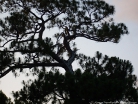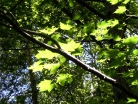
Fraser Fir, Abies fraseri (Pursh) Poir
Common Names: Balsam, Balsam Fraser Fir, Eastern Fir, Fraser's Fir, She-Balsam, Southern Fir, Southern Balsam Fir
Common Names: Balsam, Balsam Fraser Fir, Eastern Fir, Fraser's Fir, She-Balsam, Southern Fir, Southern Balsam Fir
Pests, Disease and Elemental
One of the most destructive forces affective Abies fraseri is an invasive species called the balsam wooly adelgid. This non-native bug is a serious threat to both Fraser and Balsam fir species. In 1957, infestations were first noticed in North Carolina and have since spread and are causing considerable damage. Fraser fir is also susceptible to several heart rots, root rots and is subject to windthrow. Fraser Fir has a low drought and fir tolerance.
Uses
Fraser Fir is probably best known and most recognized as a Christmas tree. Tree farms regularly grow this species for the holiday to be shipped all over the country and it is often found in nurseries as it makes a good landscape addition. In areas with high populations of white tailed deer, Abies fraseri is less likely to be browsed as it is less palatable than other food sources and may offer a solution to those with deer related landscape issues. Fraser Fir is of little commercial importance otherwise, which can be attributed to its distribution and tendency to grow in rougher, less accessible terrain. It does, however, have value in watershed protection applications as its shallow roots lend themselves to soil stabilization.
Sources:
Trees of North America- A guide to field identification-a Golden Field Guide from St. Martin's Press © 2002 By C. Frank Brockman p.46
A Natural History of North American Trees, by Donald Culross Peattier © 2007 by Houghton Mifflin Company p. 125
USDA, NRCS. 2011. The PLANTS Database (<http://plants.usda.gov/>, 22 August 2011). National Plant Data Team, Greensboro, NC 27401-4901 USA.
Sullivan, Janet. 1993. Abies fraseri. In: Fire Effects Information System, [Online]. U.S. Department of Agriculture, Forest Service, Rocky Mountain Research Station, Fire Sciences Laboratory (Producer). Available: http://www.fs.fed.us/database/feis/ [2011, August 22].
One of the most destructive forces affective Abies fraseri is an invasive species called the balsam wooly adelgid. This non-native bug is a serious threat to both Fraser and Balsam fir species. In 1957, infestations were first noticed in North Carolina and have since spread and are causing considerable damage. Fraser fir is also susceptible to several heart rots, root rots and is subject to windthrow. Fraser Fir has a low drought and fir tolerance.
Uses
Fraser Fir is probably best known and most recognized as a Christmas tree. Tree farms regularly grow this species for the holiday to be shipped all over the country and it is often found in nurseries as it makes a good landscape addition. In areas with high populations of white tailed deer, Abies fraseri is less likely to be browsed as it is less palatable than other food sources and may offer a solution to those with deer related landscape issues. Fraser Fir is of little commercial importance otherwise, which can be attributed to its distribution and tendency to grow in rougher, less accessible terrain. It does, however, have value in watershed protection applications as its shallow roots lend themselves to soil stabilization.
Sources:
Trees of North America- A guide to field identification-a Golden Field Guide from St. Martin's Press © 2002 By C. Frank Brockman p.46
A Natural History of North American Trees, by Donald Culross Peattier © 2007 by Houghton Mifflin Company p. 125
USDA, NRCS. 2011. The PLANTS Database (<http://plants.usda.gov/>, 22 August 2011). National Plant Data Team, Greensboro, NC 27401-4901 USA.
Sullivan, Janet. 1993. Abies fraseri. In: Fire Effects Information System, [Online]. U.S. Department of Agriculture, Forest Service, Rocky Mountain Research Station, Fire Sciences Laboratory (Producer). Available: http://www.fs.fed.us/database/feis/ [2011, August 22].
Photo citation: Steve Hurst @ USDA-NRCS PLANTS Database
State List: GA, NC, TN, VA Threatened in TN
Visit the Image Gallery for more pictures
Synomyms:
Pinus fraseri Pursh
Abies balsamea (L.) Mill var. fraseri Nutt.
Visit the Image Gallery for more pictures
Synomyms:
Pinus fraseri Pursh
Abies balsamea (L.) Mill var. fraseri Nutt.

Want to add your tree to our picture gallery? Click here for details!
Tree lists:
•A-Z by scientific
name
•A-Z by common
name
•By Family
For state A-Z list click state name below.
•A-Z by scientific
name
•A-Z by common
name
•By Family
For state A-Z list click state name below.
-Color denotes a tree that is rare or endangered

Map courtesty USDA NRCS PLANTS Database



Found in the eastern United States, this native conifer normally reaches around 55 feet in height and 1 foot in diameter but the largest on record is 87 feet tall and almost 3 feet in diameter. Fraser Fir, named after Scotsman John Fraser, has a moderate growth rate, only hitting 20 feet tall by age 20, and can live between 100 to 150 years of age. It has a single trunk which supports its classic Christmas tree pyramidial shape. Needles of Abies fraseri are deep
greenish blue, flat and .8 to 1.5 inches long. The root system is shallow and rarely reaches depths greater than 6 inches. Fraser Fir bark is covered with oleoresin filled blisters throughout its life but the bark between changes to almost smooth when young to scaly when mature. Small, inconspicuous purple flowers bloom in the spring, while the small male cones, .4 inches long, and the female cones, 1.5 to 2.5 inches long, are busy opening and ripening in early summer and early fall. Fraser Fir seeds are small, brown and longer than they are wide. They have a small grayish brown wing that aids in wind dispersal. Distinctive cones have bracts longer than the scales, which extend out then curl under back toward the cone and are much lighter in color than the cone itself.
Habitat
The shade tolerant native species is found at higher elevations in the Appalachian mountains, where it thrives in the cooler, temperate forest with rainfall amounts between 45 to 100 inches annually. The growing season, spring and summer, is also accompanied by fog 65% of the time. Abies fraseri is adapted to medium and coarse textured soils and typically makes its home on shallow, rocky soils.
Habitat
The shade tolerant native species is found at higher elevations in the Appalachian mountains, where it thrives in the cooler, temperate forest with rainfall amounts between 45 to 100 inches annually. The growing season, spring and summer, is also accompanied by fog 65% of the time. Abies fraseri is adapted to medium and coarse textured soils and typically makes its home on shallow, rocky soils.
While this species is shade tolerant, seedlings growth rate is severely diminished when growing in shade, sometimes not exceeding 2 to 3 feet in height by age 20. When exposed to sunlight, trees that have been suppressed by shade, may grow very rapidly. Conversely, seedlings when grown in full sunlight, will reach 8 feet tall in just 11 years. Fraser fir is hardy down to -23°F and requires only 90 frost free days a year. At lower elevations it will form mixed stands with other trees such as maple, ash, buckeye and hemlock, but tends to form pure stands in the higher elevations of its range.
Propagation
Fraser fir, although it grows in cooler temperatures, does not require cold stratification. Seed production begins around 15 years of age and trees produce a good seed crop every other year.
Propagation
Fraser fir, although it grows in cooler temperatures, does not require cold stratification. Seed production begins around 15 years of age and trees produce a good seed crop every other year.



Sunday, June 15, 2025

|
|
|
|
|
| A-Z scientific | ||
| A-Z by Common Name | ||
| Families | ||
| Browse by State | ||
| Rare or Endangered Species | ||
| Trees_with_Special_Uses | ||
| Tallest and Biggest |
| Aceraceae Maple Family | ||
| Anacardiaceae Sumac Family | ||
| Annonaceae Custard Apple Family | ||
| Aquifoliaceae Holly Family | ||
| Arecaceae, Palm Family | ||
| Betulaceae Birch family | ||
| Bignoniaceae Trumpet Creeper Family | ||
| Burseraceae Frankincense Family | ||
| Caprifoliaceae Honeysuckle Family | ||
| Chrysobalanaceae Coco-plum Family | ||
| Cornaceae Dogwood Family | ||
| Cupressaceae Cypress Family | ||
| Cyrillaceae Cyrilla Family | ||
| Ebenaceae Ebony Family | ||
| Ericaceae Heath Family | ||
| Fabaceae Pea Family | ||
| Fagaceae Beech Family | ||
| Hamamelidaceae Witch Hazel Ffamily | ||
| Hippocastanaceae Horse Chestnut Family | ||
| Juglandaceae Walnut Family | ||
| Lauraceae Laurel Family | ||
| Leitneriaceae Corkwood Family | ||
| Magnoliaceae Magnolia Family | ||
| Meliaceae Mahogany Family | ||
| Moraceae Mulberry Family | ||
| Myricaceae Bayberry Family | ||
| Myrsinaceae Myrsine Family | ||
| Myrtaceae Myrtle Family | ||
| Nyctaginaceae Four Oclock Family | ||
| Olacaceae Olax Family | ||
| Oleaceae Olive Family | ||
| Pinaceae Pine Family | ||
| Platanaceae Plane Tree Family | ||
| Polygonaceae Buckwheat Family | ||
| Rhamnaceae Buckthorn Family | ||
| Rosaceae Rose Family | ||
| Rubiaceae Madder Family | ||
| Rutaceae Rue Family | ||
| Salicaceae Willow Family | ||
| Sapindaceae Soapberry Family | ||
| Sapotaceae Sapodilla Family | ||
| Simaroubaceae Quassia Family | ||
| Styracaceae Storax Family | ||
| Symplocaceae Sweetleaf Family | ||
| Theaceae Tea Family | ||
| Tiliaceae Lindon Family | ||
| Ulmaceae Elm Family | ||
| Taxaceae Yew Family | ||
| Yucca Family |
| Maple A-Z |
| sumac_family_a-z |
| custard_apple_family_a-z |
| holly_trees_a-z |
| palm_family_a-z |
| birch_family_a-z |
| trumpet_creeper_family_a-z |
| honeysuckle_family_a-z |
| dogwood_family_a-z |
| cypress_family_a-z |
| heath_family_a-z |
| pea_family_a-z |
| beech_family_a-z |
| walnut_family_a-z |
| magnolia_family_a-z |
| olive_family_a-z |
| rose_family_a-z |
| willow_family_a-z |
| franklinia |
| elm_family_a-z |
| Federal List | ||
| State Lists | ||
| Invasive_species |
| Restoration of the American Chestnut | ||
| Restoration of the American Elm | ||
| Sustainable Forestry |
| Contact Us | ||
| Our Contributors | ||
| Photo of the Month | ||
| Usage Requirements | ||
| FAQ | ||
| Report a Broken Link |
| photo_submission |
| Photo Store |
™

Custom Search









